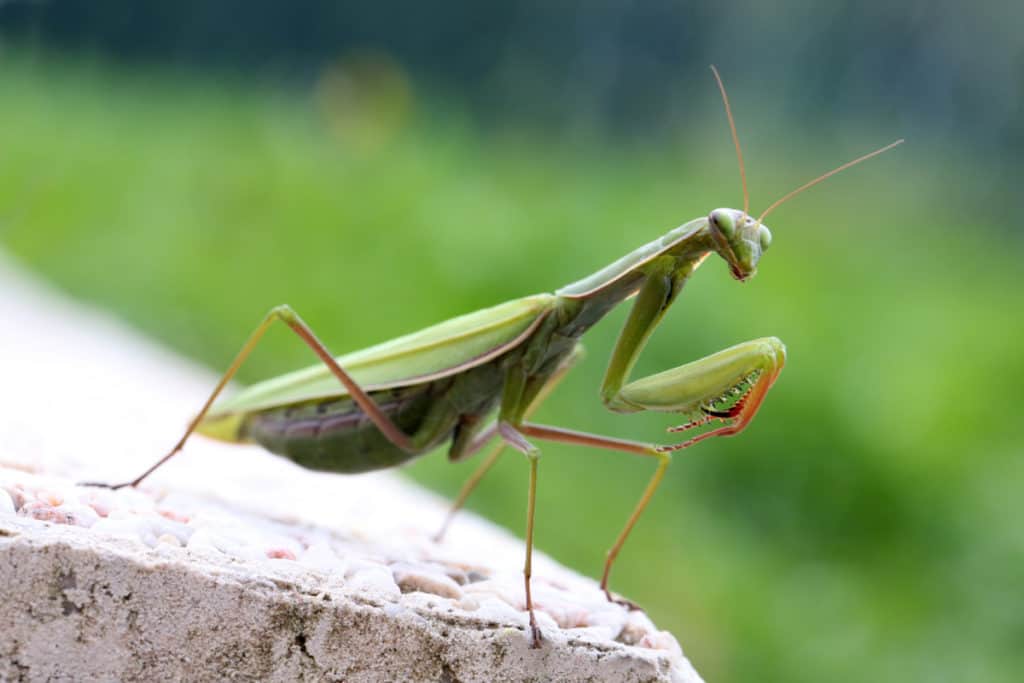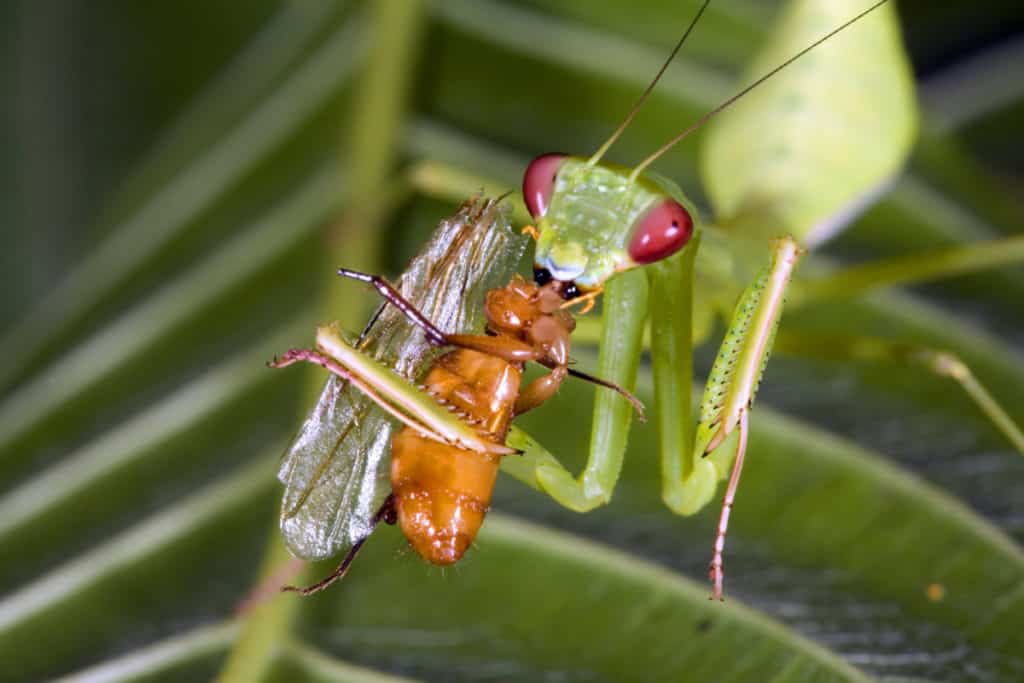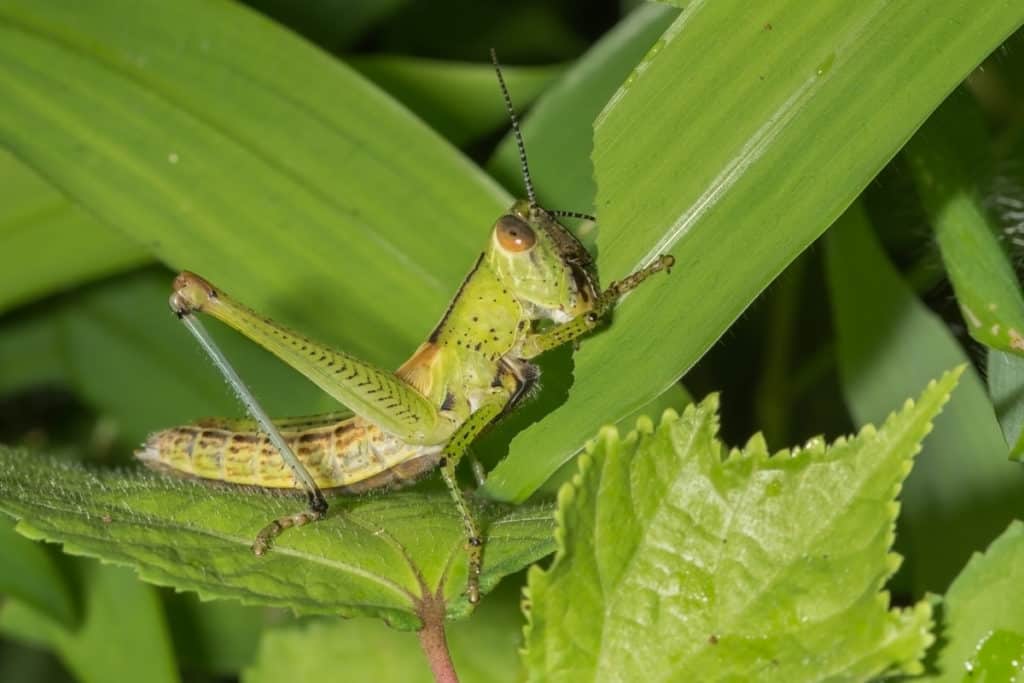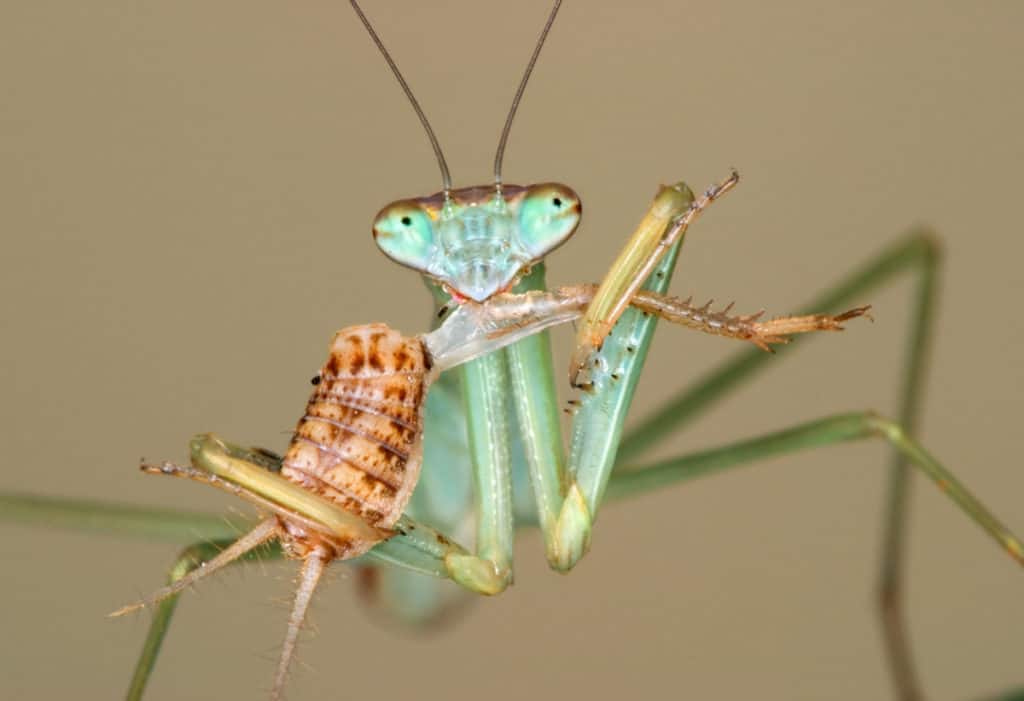One would think that these two twiggy-looking insects are basically the same. However, not only do they differ in what they eat, but they also do not look alike. Although they can both be brown or green, on many fronts, that is as far as the similarity goes.
The grasshopper and praying mantis are two different insects with the former belonging to the superorder Polyneoptera while the latter belongs to Dictyoptera. But interestingly, despite the difference in taxonomy the praying mantis belongs to the same family as the grasshopper and other insects like crickets and locusts.
Read on to find out more about the grasshopper and the praying mantis.
Appearance
Praying Mantis
The praying mantis got its name from its posture as the insect appears to be in a prayer pose constantly due to its bent front legs. It has a small triangular head that features two large compound eyes on the side and three smaller eyes in between them. The mouthparts protrude like a beak of sorts and it features mandibles. On the head, there is also a pair of antennae.

The praying mantis appears to have the neck and the thorax fused but they are both elongated. This neck is capable of turning to 180 degrees which is why these insects are difficult to creep upon. Their bodies are skinny and gangly looking and they can be brown, green, black, or even pink in color.
Do you know that some praying manits are white in color? The Orchid Mantis is one of the most beautiful of the praying mantis species. Check out this article for pictures of the Orchid Mantis and some other great looking praying mantis, Are White Praying Mantises Rare?
A praying mantis looks like a combination of twigs and a small leaf which helps it camouflage easily in its habitat. You can expect a length of two to five inches in a praying mantis depending on the species.
The praying mantis and the stick bug are often confusted with each other because of their abilities to look like leaves or twigs. We have written an article where we take a close look differences between the two. If you are interested the article is called, Praying Mantis Vs Stick Bug. Are They The Same Thing?
Grasshopper
Grasshoppers also come in black, brown, and green. They have large overgrown hind legs that help them hop from one plant to another earning them their name grasshopper. Their strong hind legs allow them to jump for long distances.
These insects have large eyes that are green, black, or brown depending on their coloring. They have chewing mouthparts on a hard capsule head. The grasshopper is not gangly but instead is stocky with little distinction between the head, thorax, and abdomen although the insect has these three parts. However, the thorax is the stockiest part of the insect.
Both insects have an exoskeleton which is like body armor helping protect the from predators. The down side is they need to molt their exoskeletons unfortunately during the molting process they are vunlarable to predators.
A grasshopper has filiform antennae meaning that they are threadlike in appearance. But depending on the species the antennae may also be ensiform, meaning they are broad at the base and thin at the tip or clavate with a thin base and broad tip. Their sizes also range between two and five inches just like the praying mantis.
Both insects have wings covering their backs and abdomen.
Both praying mantis and grasshopper typically have the ability to fly. We have written two articles about the ability to both insects to fly. If you are interested these articles are, Can Grasshoppers Fly? and Do Praying Mantises Have Wings And Can They Fly?
Habitat
Praying Mantis
The praying mantis is more adapted to tropical and subtropical terrains where they experience warm temperatures. Their preferred temperatures range between 20 and 25 degrees Celsius. Praying mantis occur naturally on grasslands, tropical forests, and meadowlands. Some species are even found in the southwestern deserts of the United States.
They also can be found in temperate regions where there is moderate rain and sporadic drought. These insects can survive the cool to cold winters of such regions by overwintering to emerge in spring.
For more details on some interesting species of praying mantis check out some of these articles we have written:
The Giant Asian Mantis: Your Complete Guide
The Devil’s Flower Mantis: Your Complete Guide
Are White Praying Mantises Rare?
The Budwing Mantis: Your Complete Guide
The Spiny Flower Mantis: Your Complete Guide
The Ghost Mantis: Your Complete Guide
Grasshopper
The grasshopper can be found in all terrains from grasslands, forests, deserts, mountains, and savannahs. There are even some species that are aquatic like the Cornops aquaticum that is native to South America and loves to feed only on specific aquatic plants of the Pontederia and Eichhornia genus. However, aquatic grasshoppers are not pests like other species.
Grasshoppers are prolific pests that can survive where they find food and that is why they can move to different terrains. They, however, prefer drier terrains with low-lying plants and plenty of grass that works as camouflage. It is not surprising to find these insects in temperatures of between 30 and 44 degrees Celsius.
Do you live in Florida? We do have a guide to the grasshoppers you will find there. The article is called, Grasshoppers In Florida: Your Complete Guide.
What Do They Eat?
Praying Mantis
A praying mantis is a carnivorous insect feeding on live insects and other prey. Their nymphs feed on insects like thrips and aphids among others. The adults eat crickets, spiders, butterflies, bees, and yes, grasshoppers.

The voracious insects are excellent ambush predators meaning that they wait for their prey to come their way. They pounce on the prey with lightning speed and sink the pointy, sharp spikes on their legs into their victim. With the prey held in place, the predator proceeds to eat it from the head area in order to minimize the chances of their prey trying to escape.
They do not have venom so they eat their victims while they are still alive from the head going downwards.
The praying mantis does not eat dead insects-they only feed on the food they have killed themselves and they tend to feed at night.
If you are interested we have a full article with all the gory details on the diet of praying mantis. The article is called, What Does A Praying Mantis Eat?
Grasshoppers
These are primarily herbivorous insects and their mouthparts are designed to cut through and chew plants. Their head is generally tilted downwards so their mouthparts are also downward-facing for easy access to leaves, flowers, and stems of the plants they devour.

Grasshoppers are not selective about the plants they eat but they generally favor green leafy plants. When they are done eating green plants, they can eat moss, fungi, or even animal dung.
Some species can nibble on dead insects like flies and spiders to get some protein from them. But generally, they subsist on a diet of plant life. Grasshopper eats both day and night.
One weird question we have been asked is whether grasshoppers eat ants? So we wrote an article to cover this in detail. Check it out if you are interested, Do Grasshoppers Eat Ants? Or Is It The Other Way Around?
Are They Good Or Bad For Your Garden?
Praying Mantis
Praying mantises are good for your garden because they feed on the pests that harm your plants and crops. However, they can also be bad for the garden with their indiscriminate feeding of even the beneficial insects like butterflies and bees which are excellent pollinators.
With praying mantis in your garden, you do not have to worry about aphids, grasshoppers, and even mice that attack your crops. Considering the fact that they eat their own siblings, and even mates, you cannot control their appetites once you introduce them into your garden.

Grasshoppers
As herbivores, these insects can be beneficial for your garden because of their droppings which act as manure. They also become food for birds and mantises which also control other pests in your garden.
However, they can become ferocious pests when they attack your garden, farm, or orchard because they indiscriminately devour everything in sight. To put his in perspective, consider a hayfield and the fact that six to seven grasshoppers per square yard can eat as much hay as one cow in a day. Around 20 grasshoppers per square yard can eat a ton of hay daily.
They can destroy an entire crop leaving farmers with nothing to harvest. Unchecked grasshopper populations can cause food insecurity for an entire country. And because they can eat both day and night, they consume large quantities.
If you are interested in understanding how grasshoppers can become such a destructive pest so rapidly check out this article we have written, The Lifecycle Of Grasshoppers.
Are They Harmful To You Or Your Pet?
The good news is that both grasshoppers and praying mantises are not a danger to human beings or pets. They do not attack human beings and also, they are not vectors for any diseases.
Unfortunately, grasshoppers can transmit a virus to plants that are then transmitted to the animals that eat the plants. The virus is known as vesicular stomatitis or VSV. The virus causes the animal to get painful blisters and to salivate heavily. VSV is transmitted via animal-to-animal interactions with the saliva of infected livestock. But the condition only attacks hoofed animals.
Time Of The Year They Active
Praying Mantis
The praying mantis becomes active from spring when they emerge from the winter and their eggs hatch. Their mating season is the summer and into the fall before they lay their eggs on the stem of plants and overwinter. During the mating season, the males are most active as they look for a mate.
Grasshoppers
From early May to mid-October grasshoppers are busy feeding on the growing native perennial grasses. They hatch from their eggs in spring and reach full maturities in the late summer and early fall. This is similar to the cycle of praying mantis.
Taxonomy
The taxonomy of the praying mantis is as follows
- Kingdom: Animalia
- Phylum: Arthropoda
- Class: Insecta
- Superorder: Dictyoptera
- Subfamily: Mantodea
- Family: Mantidae
The taxonomy of the grasshopper is as follows
- Kingdom: Animalia
- Phylum: Arthropoda
- Class: Insecta
- Superorder: Polyneoptera
- Order: Orthoptera
- Suborder: Caelifera
- Infraorder: Acrididae
The grasshopper has seven super-families which are
- Acridoidea
- Eumastacoidea
- Pneumoroidea
- Proscopioidea
- Tanaoceroidea
- Trigonopterygoidea
Can They Be Kept As Pets?
The praying mantis and grasshopper make excellent pets. But grasshoppers are more inexpensive because they just need plants for sustenance. But the praying mantis requires you to constantly have access to live food and they need to be monitored especially during their molting seasons.
You can keep both as pets but just not in the same cage. The praying mantis will think the grasshopper is its meal.
| Grasshopper | Praying mantis |
| It is herbivorous | It is carnivorous |
| It doesn’t have an elongated neck | Has an elongated neck |
| Cannot turn its head | Can turn its head 180 degrees |
The Wrap Up
Both the grasshopper and praying mantis are hemimetabolous, meaning they have incomplete metamorphosis. They go from the egg to becoming nymphs that are identical to the adults. This is one of the few similarities that these insects have. But generally, they are two different insects with a very different ways of life.
Sources
http://www.uwyo.edu/entomology/grasshoppers/field-guide/ghparts.html
https://www.nationalgeographic.com/animals/invertebrates/p/praying-mantis/
https://www.scielo.sa.cr/scielo.php?script=sci_arttext&pid=S0034-77442011000300037
https://www.wikihow.com/Take-Care-of-a-Praying-Mantis
https://sciencing.com/do-grasshoppers-eat-5655099.html
https://www.sciencedaily.com/releases/2009/08/090830091156.htm
